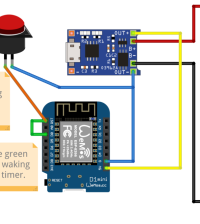- How to Adjust X and Y Axis Scale in Arduino Serial Plotter (No Extra Software Needed)Posted 3 months ago
- Elettronici Entusiasti: Inspiring Makers at Maker Faire Rome 2024Posted 3 months ago
- makeITcircular 2024 content launched – Part of Maker Faire Rome 2024Posted 5 months ago
- Application For Maker Faire Rome 2024: Deadline June 20thPosted 7 months ago
- Building a 3D Digital Clock with ArduinoPosted 12 months ago
- Creating a controller for Minecraft with realistic body movements using ArduinoPosted 1 year ago
- Snowflake with ArduinoPosted 1 year ago
- Holographic Christmas TreePosted 1 year ago
- Segstick: Build Your Own Self-Balancing Vehicle in Just 2 Days with ArduinoPosted 1 year ago
- ZSWatch: An Open-Source Smartwatch Project Based on the Zephyr Operating SystemPosted 1 year ago
Linux Foundation launches the Open-source EdgeX Foundry for IoT standardisation

Security is the Achilles heel of the Internet of Things, according to Steven J. Vaughan-Nichols on ZDNet.
The lack of common IoT development standards is part of this problem. This is why the Linux Foundation, along with 50 companies, has announced The EdgeX Foundry. The group will build a common open framework for IoT edge computing that will include an ecosystem of interoperable components.
“The initial work is already in place. Dell is seeding EdgeX Foundry with its early stage FUSE source code base under Apache 2.0. FUSE forms a layer that will sit between the many different messaging protocols used by today’s sensor networks and the cloud and server layers.
EdgeX will foster an ecosystem of interoperable components from a variety of vendors, so that resources can be spent on driving business value instead of combining and integrating IoT components.”
The EdgeX members are adopting an open-source edge software platform because it will help everyone in the IoT business world.
- End customers can deploy IoT edge solutions quickly and easily with the flexibility to dynamically adapt to changing business needs.
- Hardware Manufacturers can scale faster with an interoperable partner ecosystem and more robust security and system management.
- Independent Software Vendors can enjoy interoperability with third-party applications and hardware without reinventing connectivity.
- Sensor/Device Makers can write an application-level device driver with a selected protocol once using the SDK and get pull from all solution providers.
- System Integrators can get to market faster with plug-and-play ingredients combined with their own proprietary inventions.
Maybe an interoperable, open-source based IoT world will be far safer and better for both vendors and consumers.















